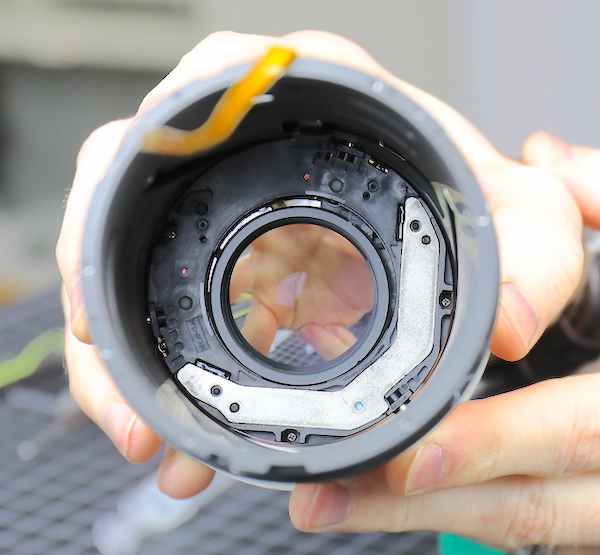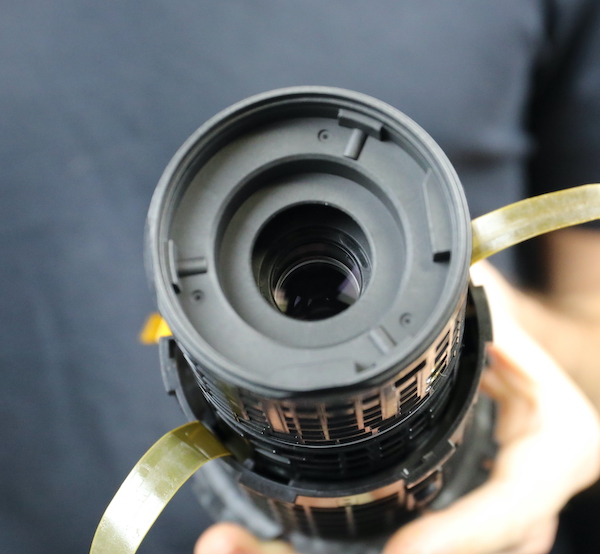I noticed that my Rf 100-500mm f/4.5-7.1L IS lens exhibited a surprising amount of free movement of the visible part of the image-stabilization cylinder. With no camera attached, looking down through the front element, and gently tilting the lens in different directions, I can see the topmost element bumping and tapping against the inner-barrel.
When the lens is attached to a body with IS on, the movement is different, showing that the IS system is compensating. With the body on but IS switched off, the visible inner element is held rigidly.
From a new owner's standpoint, I was concerned that this movement I'm seeing might be more than what is normal for this lens, and that it could, over time, result in elements getting bumped out of alignment.
Some of you will have read my posts elsewhere asking for others to check their own lens. Since then I have had nearly two hours of conversations with Canon CPS, which has helped bring the issue into better focus.
Three CPS techs, two whom I spoke to directly, and one involved by relay, expressed surprise, because they thought the IS system would be parking when the lens was attached to a camera that had been powered off, or when the lens was not attached to a camera. We walked through the proper sequence for parking (something I had believed to not be relevant to newer lenses), and whether I powered off the IS while the body was still active or not, the 100-500mm's elements behave exactly the same--no parking.
Being the last few days of the year, and up against the weekend, the techs said that they are going to start "digging deeper" next week. They said they did have a surprising number of customers calling to ask about unusually loud IS sounds from the 100-500mm, but had not considered whether is was parking or not.
So my case is being looked into further. Naturally, in the meantime, I searched the web to find more about this issue, and only found two primary references (and a bunch referring vaguely or directly to the two I found).
First is from Canon, an article from Rudy Winston about noises from IS lenses, and about the procedure for parking IS lenses:
Canon U.S.A., Inc. | Whats-That-Rattling-Sound-From-Your-Image-Stabilized-Lens
The other is a briefer mention in a lensrentals.com blog post:
Lens Rentals | Blog
This leaves me wondering whether the 100-500mm should be parking. Common sense suggests that lens elements should be kept fairly well secured when the lens is not being used, so that the elements aren't gradually getting nudged out of alignment. (I think of it as analogous to hard disk drives parking when powered off.) Now I'm not planning to run cross-country with my 100-500mm, but I do hike and walk about 15-20 miles a week for fitness and health, and I'd like that lens with me most of the time. I'd like to know that it is not going to need an expensive realignment from time to time due to not parking properly. Being an early adopter is fun and exciting, but it also leaves us with no info about long-term issues.
I will, as expected, share what Canon CPS tells me next week, but in the meantime, anybody interested in this, please look at your own longer lenses with IS and share how they behave according to Rudy Winston's suggestion to let the IS system stop for a few seconds before turning off the camera. Do you see more movement if the lens is parked or not?
Maybe others here have been through all this. What exactly should be parking? How well secured should those elements be when IS is not energized?
I've checked my other RF lenses, the 24-70mm and 70-200mm. As might be expected, the 24-70mm has barely discernible movement inside when detached, and the 70-200mm a slight bit more--but it doesn't have that same freely bumping and tapping movement, maybe just because it is much shorter than the 100-500mm.
Happy 2021!
When the lens is attached to a body with IS on, the movement is different, showing that the IS system is compensating. With the body on but IS switched off, the visible inner element is held rigidly.
From a new owner's standpoint, I was concerned that this movement I'm seeing might be more than what is normal for this lens, and that it could, over time, result in elements getting bumped out of alignment.
Some of you will have read my posts elsewhere asking for others to check their own lens. Since then I have had nearly two hours of conversations with Canon CPS, which has helped bring the issue into better focus.
Three CPS techs, two whom I spoke to directly, and one involved by relay, expressed surprise, because they thought the IS system would be parking when the lens was attached to a camera that had been powered off, or when the lens was not attached to a camera. We walked through the proper sequence for parking (something I had believed to not be relevant to newer lenses), and whether I powered off the IS while the body was still active or not, the 100-500mm's elements behave exactly the same--no parking.
Being the last few days of the year, and up against the weekend, the techs said that they are going to start "digging deeper" next week. They said they did have a surprising number of customers calling to ask about unusually loud IS sounds from the 100-500mm, but had not considered whether is was parking or not.
So my case is being looked into further. Naturally, in the meantime, I searched the web to find more about this issue, and only found two primary references (and a bunch referring vaguely or directly to the two I found).
First is from Canon, an article from Rudy Winston about noises from IS lenses, and about the procedure for parking IS lenses:
Canon U.S.A., Inc. | Whats-That-Rattling-Sound-From-Your-Image-Stabilized-Lens
The other is a briefer mention in a lensrentals.com blog post:
Lens Rentals | Blog
This leaves me wondering whether the 100-500mm should be parking. Common sense suggests that lens elements should be kept fairly well secured when the lens is not being used, so that the elements aren't gradually getting nudged out of alignment. (I think of it as analogous to hard disk drives parking when powered off.) Now I'm not planning to run cross-country with my 100-500mm, but I do hike and walk about 15-20 miles a week for fitness and health, and I'd like that lens with me most of the time. I'd like to know that it is not going to need an expensive realignment from time to time due to not parking properly. Being an early adopter is fun and exciting, but it also leaves us with no info about long-term issues.
I will, as expected, share what Canon CPS tells me next week, but in the meantime, anybody interested in this, please look at your own longer lenses with IS and share how they behave according to Rudy Winston's suggestion to let the IS system stop for a few seconds before turning off the camera. Do you see more movement if the lens is parked or not?
Maybe others here have been through all this. What exactly should be parking? How well secured should those elements be when IS is not energized?
I've checked my other RF lenses, the 24-70mm and 70-200mm. As might be expected, the 24-70mm has barely discernible movement inside when detached, and the 70-200mm a slight bit more--but it doesn't have that same freely bumping and tapping movement, maybe just because it is much shorter than the 100-500mm.
Happy 2021!
Last edited:


